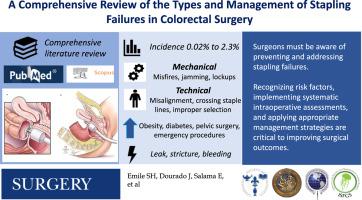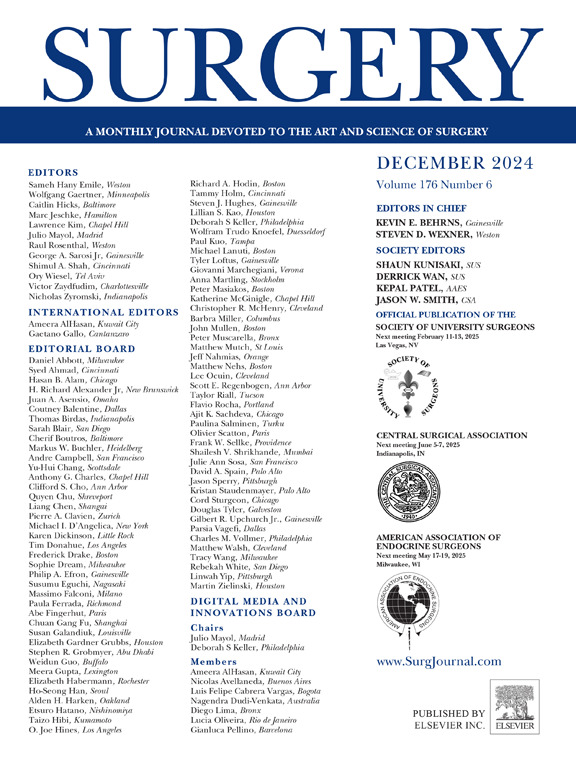结直肠手术中吻合器失败的类型和处理的综合综述
IF 2.7
2区 医学
Q1 SURGERY
引用次数: 0
摘要
虽然外科吻合器显著提高了结直肠手术的性能,但吻合器失败会影响手术效果。了解这些并发症的机制及其管理对提高患者安全至关重要。这篇综述的目的是提供一个关于装订失败的类型和管理的现有文献的简要总结。方法对截至2025年2月的PubMed和Scopus数据库进行综合文献综述,以确定报道结直肠手术中钉接失败的类型、机制、检测方法和管理的研究。各种类型的外科吻合器用于结直肠手术,包括圆形和线性吻合器开放和腹腔镜手术,考虑。结果结直肠手术吻合器失败率为0.02% ~ 2.3%。订书机故障包括一系列机械故障和技术错误。机械故障包括失火、堵塞和锁定。技术故障包括不对准、短钉线交叉、选择不当和技术差。危险因素包括与患者相关的因素,如肥胖和糖尿病,以及手术因素,如盆腔手术、紧急手术和直肠活动不足。吻合器失败的后果包括吻合口渗漏、狭窄和出血。系统的检测方法,如Wexner四重评估,有助于检测装订事故。处理取决于并发症的性质和术中故障排除,包括加固缝线、吻合口翻修和粪便分流。结论外科医生必须精通预防和处理缝合失败,以优化患者的预后。认识危险因素,实施系统的术中评估,并采用适当的管理策略是提高手术效果的关键。本文章由计算机程序翻译,如有差异,请以英文原文为准。

A comprehensive review of the types and management of stapling failures in colorectal surgery
Introduction
Although surgical staplers have significantly advanced the performance of colorectal surgery, stapling failures can compromise surgical outcomes. Understanding the mechanism of these complications and their management is crucial for improving patient safety. This review aims to provide a succinct summary of the existing literature on types and management of stapling failures.
Methods
A comprehensive literature review of PubMed and Scopus databases through February 2025 was conducted to identify studies that reported types, mechanisms, detection methods, and management of stapling failures in colorectal surgery. Various types of surgical staplers used in colorectal surgery, including circular and linear staplers for open and laparoscopic procedures, were considered.
Results
The incidence of stapling failures in colorectal surgery ranges from 0.02% to 2.3%. Stapling failures encompass a range of mechanical failures and technical errors. Mechanical failures include misfires, jamming, and lockups. Technical failures include misalignment, crossing staple lines, improper selection, and poor technique. Risk factors include patient-related factors such as obesity and diabetes, and surgical factors such as pelvic surgery, emergency procedures, and inadequate rectal mobilization. The consequences of stapling failures include anastomotic leaks, strictures, and bleeding. Systematic detection methods such as the Wexner quadruple assessment help detect stapling misadventures. Management depends on the nature of the complication and intraoperative troubleshooting, and includes reinforcement sutures, anastomotic revision, and fecal diversion.
Conclusion
Surgeons must be well-versed in preventing and addressing stapling failures to optimize patient outcomes. Recognizing risk factors, implementing systematic intraoperative assessments, and applying appropriate management strategies are critical to improving surgical outcomes.
求助全文
通过发布文献求助,成功后即可免费获取论文全文。
去求助
来源期刊

Surgery
医学-外科
CiteScore
5.40
自引率
5.30%
发文量
687
审稿时长
64 days
期刊介绍:
For 66 years, Surgery has published practical, authoritative information about procedures, clinical advances, and major trends shaping general surgery. Each issue features original scientific contributions and clinical reports. Peer-reviewed articles cover topics in oncology, trauma, gastrointestinal, vascular, and transplantation surgery. The journal also publishes papers from the meetings of its sponsoring societies, the Society of University Surgeons, the Central Surgical Association, and the American Association of Endocrine Surgeons.
 求助内容:
求助内容: 应助结果提醒方式:
应助结果提醒方式:


